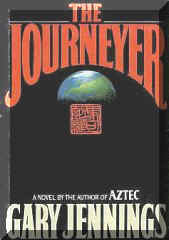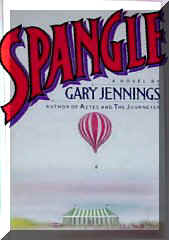

"Gary Jennings is the best among our historical novelists." - The New York Times
|
Gary
Jennings is a well-known author of epic historical
novels, each one set in a different period but all sharing the theme of
survival by wit and chance in violent times. These sprawling works,
sometimes reaching 500,000 words, are packed with violence, braggadocio
and vivid sex scenes. Gary Jennings usually structures his historical
novels around a narrator who comes of age in the vicissitudes of the
story and then takes his or her life lessons into an adulthood fraught
with danger and sexual escapade. Carefully researched and possessing a
wealth of period detail, Gary Jennings's novels have earned him praise
as "a historical novelist of the first order," according to Christian
H. Moe in Twentieth-Century Historical
Writers. |
||||||
|
Aztec "has everything that makes a story vulgarly appealing, in the best sense of the phrase," remarked Christopher Lehmann-Haupt of the New York Times. "It has sex--my goodness, does it have sex! and it has violence." While these elements may be appealing, "the violence usually serves a constructive storytelling purpose and the sexual passages almost always relate to the book's most fascinating and subtle aspect, which is the way the hero, Mixtli, unconsciously re-enacts the life of the Indian god Quetzalcoatl," continued Lehmann-Haupt. "It is this particular dimension of Aztec which raises it above the level of a mere historical potboiler. This historical novel represents a triumph of research over art." "Gary Jennings has produced in Aztec a monumental novel," noted Nicholas Shakespeare in the London Times. Gary Jennings unfolds the story of the overthrow of the Native Mexicans through the voice of an amiable but wry Aztec adventurer named Mixtli. Judith Matloff observed in the Saturday Review: "In picaresque fashion, Mixtli travels the length and breadth of Mexico, working as scribe, merchant, warrior, and ambassador to Montezuma," thus becoming involved in various aspects of the war against the conquistadors. In addition, the novel contains an abundance of details about the Aztecs--their culture, their religion, their customs, their daily life. In preparing to write the novel, Gary Jennings lived for twelve years in Mexico while conducting research on Aztec culture and the Spanish conquest. He read many accounts about the wars but found many of them biased against the Indians. So, as Gary Jennings told John F. Baker in a Publishers Weekly interview, "I learned to interpret the ancient pictures and codices and read Nahuatl, the Aztec language...it shows them as people who had a sense of the bawdy, and who had all sorts of human reactions. I wanted to bring them alive as flesh-and-blood people." The author traveled about the country, seeking primary sources and "trying to get a sense, from living Indians, of their legendary past," recounted Baker. Gary Jennings's research paid off, for the voice of his narrator Mixtli is filled with resonance of the Nahuatl speech. As Times Literary Supplement contributor Gordon Brotherston commented, "Much of the novel's power stems from Nahua sources transcribed into the alphabet after the Spanish invasion, not just the direct quotations from Nahua poems and of set pieces but the whole range of devices used by Mixtli to keep his audience alert." "Historical novels are most often praised or dismissed as novels," observed Thomas M. Disch in the Washington Post Book World, "but surely it is their power as narrative history that is their main strength, the power to evoke the feel of ages lost to memory. So it is with Gary Jennings's Aztec."
Reviews of "Aztec"
Washington Post "Of Conquistadors and Kings" The Times Literary Supplement, "Mixtli Impressions" Baltimore Sun, "Is This Novel Montezuma's Revenge?" Américas, "Truth That Reads Like Fiction" Novel & Short Story Writer’s Market, "Writing 'the Other Half' of History" The London Times The San Diego Magazine Nuestro The Chicago Tribune Texas Monthly, "Blood Luster" |
||||||
 |
In
The Journeyer,
Gary Jennings relates the "other half" of Marco Polo's adventures.
"Readers of his marvelously evocative first novel, ''Aztec,'' will not
be too surprised to learn that his rendering of that untold half
involves mainly sex, violence and the exotic. Indeed the only question
that remains once we have started reading ''The Journeyer'' is, how is
Mr. Jennings going to sustain his narrative, considering that within the
first few dozen pages of this nearly 800-page extravaganza, we have
already had four copulations, a flogging and a murder. Moreover,
enfolded into a disquisition on the prevalence of virginity among
13th-century Venetian women, there is Marco Polo's speculation that
''the fishermen's annual catch of discarded infants would seem to
indicate a scarcity of 'good' Venetian girls.'' How does Mr. Jennings
sustain our interest? He does it very effectively, thank you. One can't
really call his sexual passages pornographic, since they always serve to
advance his story, and storytelling, in Mr. Jennings's hands at least,
is distinctly a form of art. Mr. Jennings is good at this because he has
learned and included all manner of exotic 13th-century words for the
sexual parts and actions. This serves to remove his prose from vulgarity
and lift it to a low level of poetry. He also knows when enough is
enough. Nor can one really call him a sadist. He is too full of humor,
affection and humanity. Yet he has managed to surpass even the cruelty
of his earlier book, ''Aztec.'' - The New York Times. "The real energy of Gary Jennings's narrative is devoted to those old
standbys lust and bloodlust. His zeal for clinical description of
sexual practices is matched only by his enthusiasm for the minutiae of
Oriental torture. Pound for pound, 'The Journeyer' is a classic." wrote
Gene Lyons in Newsweek. "As Gary Jennings did for
pre-Hispanic Mexico in Aztec," commented Grover
Sales in the Los Angeles Times Book Review, "he has
enriched The Journeyer with an anthropologist's
knowledge of diverse lands and cultures." Added the critic: "Gary
Jennings combines inexhaustible research with the yarn-spinner's art,
drawing indelible portraits of Marco and his companions on the long
journey." Chicago Tribune Book World contributor
Jack Dierks similarly found the novel engrossing, explaining that
"employing both great sweep and meticulous detail, Gary Jennings has
produced an impressively learned gem of the astounding and the
titillating. As pure travelogue it is impeccable, and the adventures
that befall our heroes come like tales spun out by some erudite and
prurient Scheherazade, heaping wonder onto oddity." Sales offered the
opinion that "with astonishing speed and consummate skill, novelist
Gary Jennings has capped his 1980 Aztec," while
Dierks considered the book an "even more compelling work of
derring-do." Reviews of "The Journeyer" NY Times, "Books of The Times" NY Times, "Books in Short" People Magazine Kirkus Reviews UPI Archives "The Dictionary of Torture" Author Review |
|||||
 |
For
Raptor, Gary Jennings pressed further into the
past than ever before. Set in the fifth century A.D.--and framed by
Theodoric the Great's conquest of Rome--Raptor tells
the story of a wily hermaphrodite named Thorn and his/her adventures in
Theodoric's employ. Styling the work "a ripping yarn,"
New
York Times Book Review contributor Joe Queenan noted: "Generally, the author
(whose previous books include "Aztec" and "The Journeyer") avoids
straying very far from his pay dirt material -- decapitations, gang
rapes, crucifixions, bisexual orgies." Thorn's response to his/her situation
is to become a predator--a raptor like the hawk he/she has tamed--in
order to protect himself/herself and his/her interests. "Thorn is a
memorable character, and unique outside of science fiction," wrote
Judith Tarr in the Washington Post Book World.
"Raptor is a splendid entertainment: a historical novel of the old
school, impressively researched and remarkably accurate--and above all,
a roaring good read." In the New York Times,
Lehmann- Haupt declared that Gary Jennings's "latest boisterously
imaginative historical extravaganza . . . recaptures some of the magic
of `Aztec.'" The critic concluded: "If you loved `Aztec,' then you'll
love `Raptor.' And if you haven't read `Aztec,' then prepare yourself
for astonishment." Reviews of "Raptor" NY Times, "Back When 'Ostrogoth' Was Not a Dirty Word" Washington Post, "Love Among the Ostrogoths" NY Times, "Hermaphrodites in Love" Kirkus Reviews Publishers Weekly |
|||||
 |
For
Spangle,
Gary Jennings traveled with nine different circuses in America and
Europe. "Why does one keep reading this immense and complicated story?
Why does one get lost in it, and replay scenes from it as one drops off
to sleep at night? It's easy enough to describe the book's machinery.
There's the lore of circus life that Mr. Jennings details - why
contortionists tend to have weak lungs, how animal trainers speak German
to their charges because it is the language of command, or what sounds
ventriloquists avoid to keep from moving their lips. Like the
author's previous works, Spangle
contains the same elements of spectacle, sex, violence, and detail that
mark most of his historical fiction. Yet for Gary Jennings, the formula
seems to work uniquely. There is something mesmerizing about the world
he creates, perhaps because as its god he is so wantonly cruel. He is a
bedtime storyteller who goes too far, frightening the children and
keeping them up past their bedtime. One could almost accuse him of being
a sadist, what with the sexual perversions he describes and the endless
physical tortures he dreams up...No, the charm of ''Spangle'' lies in
its remarkable energy and its inventiveness of endless detail. " -
The New York Times. Los Angeles Times Book
Review contributor MacDonald Harris felt that
Spangle
"is impressive in its sheer mass and richness, in the enthusiasm and
energy of its telling, in the obvious pleasure the author takes in the
work." This enthusiasm, asserted Harris, "is contagious. Before the
novel is over we develop, along with the characters, a contempt for
non-circus people and a conviction that the only sensible and reasonable
thing to do . . . is to run away and join a circus." Spangle has been
serialized into three paperbacks: The Road Show (Spangle Part One),
Center Ring (Spangle Part Two), and Grand Promenade (Spangle Part
Three). Reviews of "Spangle" Publishers Weekly LA Times, "10,000 Secrets of the Circus" NY Times, "Books of the Times" Kirkus Reviews |

|
||||
 |
Aztec Autumn
"is a bloody tale of revenge...Offered in the form of an as-told-to
first-person journal, Jennings's fascinating if often gory novel is
guided by exhaustive research into practically every facet of life in
16th-century Mexico...Near the beginning of his fifth and latest
historical novel, ''Aztec Autumn,'' Gary Jennings, with his usual taste
for grotesque violence, describes the public burning of a man in the
central square of 16th-century Mexico City..So begins Mr. Jennings's
sequel to his first and best book, ''Aztec,"..the magic of the earlier
book seems back, that beguiling combination of innocence and obscenity
that somehow suits the violent sweetness of the ancient Aztec world. With his vigorous prose and clearly visualized details, Gary Jennings
brings readers back in time to that world. Descriptions of landscape
and culture, gruesome battle scenes and executions, have convincing
immediacy. This is riveting historical fiction written with wonderful
force." - The New York Times Reviews of "Aztec Autumn" NY Times "Innocent, Bloodthirsty and Bent on Vengeance" NY Times, "Books in Brief" Publishers Weekly Kirkus Reviews Washington Post "A Kingdom Crumbles" | |||||
|
Reviews, short stories, and
commentary by Gary Jennings "Mysterious Vanishings (And Grunting Sounds)" Academic articles on "Aztec" "The Aztec World of Gary Jennings" by Michael Smith, and "My Indignant Response" by Gary Jennings "Historicity versus Fictionality: An Interview with Dr. Michael E. Smith" by Vassilaki Papanicolaou "The Indigenous as the Malleable 'Other' Doomed to Subjugation" by Jose C. Salazar |
|||||
|
"I'm a writer. I write not only for a living, I write because I'm a writer." - Gary Jennings
©1999-2022
GaryJennings.com
|
||||||